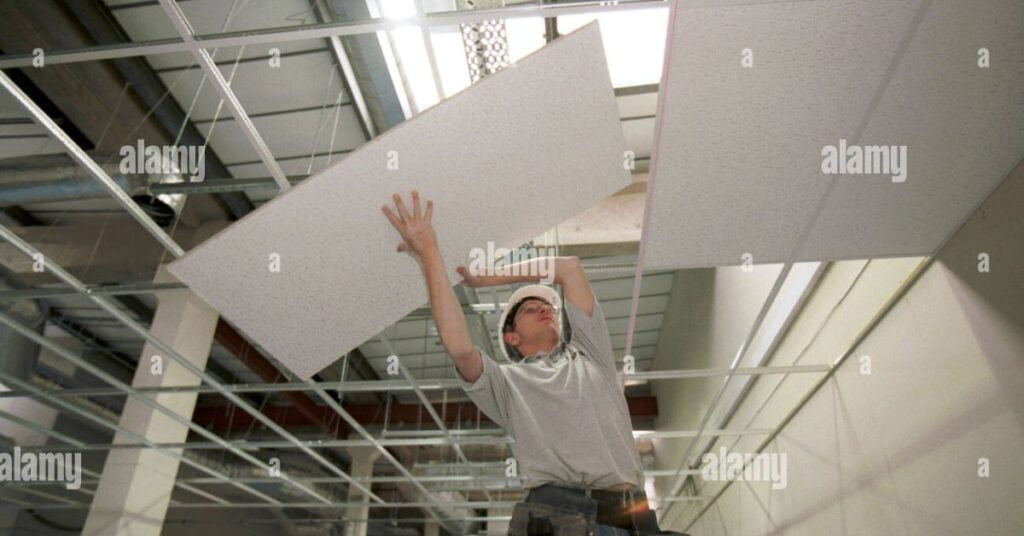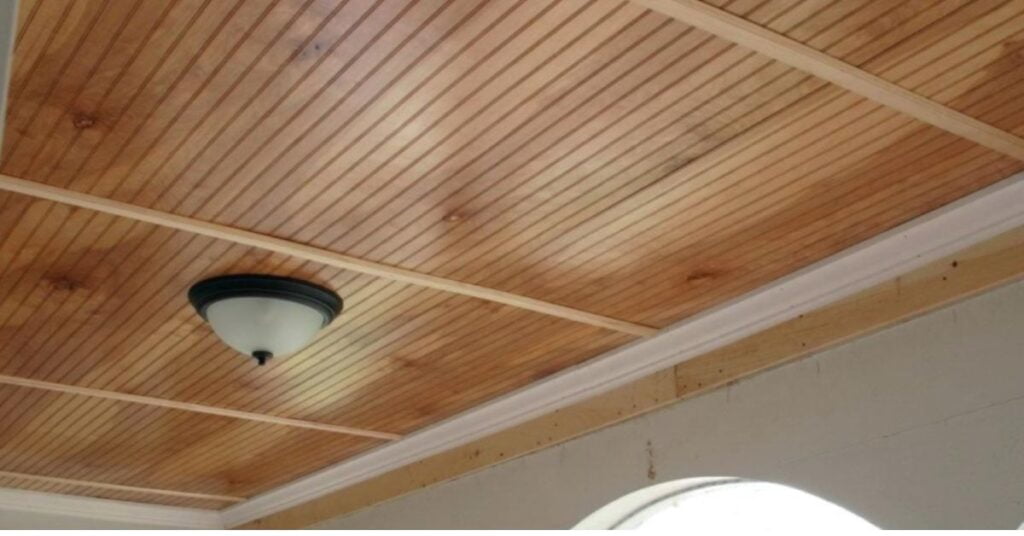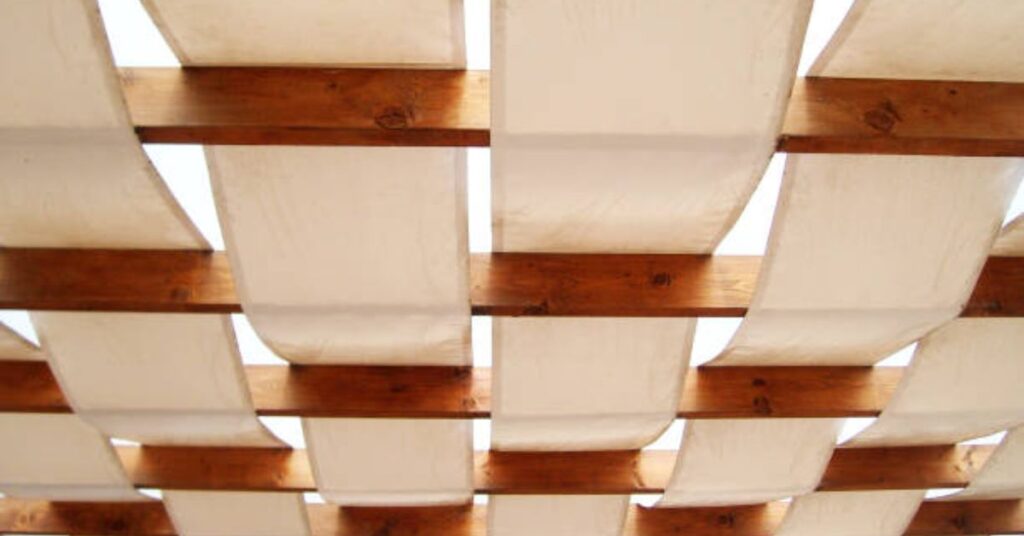These below-listed Affordable basement ceiling ideas for homes generally overlook the basement, which provides limitless opportunities for adding extra living space, a home office, or entertainment facilities.
Unfinished basements frequently have exposed ductwork, electrical wires, and pipes, which can make the area appear old and uninviting.
But fear not, as there are several affordable basement ceiling ideas that may turn your basement into a warm and welcoming living area.
- Exposed painted ceiling
- Tiles hanging from the ceiling
- Ceiling with beadboard
- Tin ceiling tiles with stamps
- Textile ceiling
This post will focus on the top affordable basement ceiling ideas that homeowners can take into account when remodeling their area.
These above are inexpensive methods to conceal a basement ceiling without going over budget, ranging from straightforward paint jobs and ceiling tiles to more sophisticated designs and materials.
A finished basement with a fashionable and useful ceiling can significantly increase the value of your house, whether you want to build a home theatre, a game room, or an extra bedroom.
Let’s get started in Detail with the greatest and most affordable basement ceiling ideas for basements so you can turn your unfinished basement into a cozy and welcoming environment.
if you want to learn about the basics of the basement, we recommend you read this article.
Types Of Affordable Basement Ceiling Ideas
Exposed Painted Ceiling

Benefits of keeping the ceiling exposed: keeping the ceiling uncovered is a growingly popular trend in interior design, and it has several benefits for basement renovations.
The value for money of this choice is one of its most notable advantages. In comparison to other ceiling solutions, exposed ceilings don’t call for any additional installations or supplies, which can result in considerable financial savings for homeowners.
Additionally, if you want to give your basement a more informal and relaxed feel, an open ceiling might provide an industrial or rustic style. Additionally, an uncovered ceiling can provide the impression of height and depth, making the room feel bigger and more open.
Tips for painting an exposed ceiling: To give a painted exposed ceiling a finished appearance, you should take certain safety measures and adhere to certain guidelines.
To begin, carefully clean the ceiling to get clear of any spider webs, dirt, or additional particles. Use a primer after cleaning the area to make sure the paint sticks to the ceiling nicely.
After that, evenly apply two coats of paint with a paint roller. Additionally, you might wish to paint the corners and edges using a brush.
Basement color schemes: When selecting a color scheme for a painted exposed basement ceiling, it’s crucial to take the atmosphere and design of the room into account.
Darker hues like navy blue or charcoal grey can lend a cozy and intimate ambiance, while lighter hues like white or light grey can make an area appear bright and airy.
To add some visual appeal and contrast, you could also want to think about adding splashes of color through accent walls, furniture, or decor.
A trendy and stylish appearance can be achieved with an exposed ceiling and metallic finishes like gold or silver with affordable basement ceiling ideas. In the end, the color palette you select should express your taste and harmonies with the general layout of your basement room.
Tiles Hanging From The Ceiling

Tiles for suspended ceilings are what?
Individual tiles that are suspended from the ceiling using a metal grid system are called suspended ceiling tiles, often known as drop ceiling tiles. this is another good option for affordable basement ceiling ideas.
To create a clean and even ceiling surface, the metal grid must first be fitted before the tiles can be set into it.
Hanging tiles for ceilings are available in an extensive range of shapes, sizes, and hues and frequently consist of substances like mineral fiber, glass fibers, or polyethylene.
Benefits of using suspended ceiling tiles: Using suspended ceiling tiles has several advantages over other types of ceiling. First off, since they are typically less expensive than other ceiling materials like plasterboard or plasterboard, suspended ceiling tiles are a cost-effective solution.
Additionally, they are simple to install, and the metal grid design makes it simple to access any possible ceiling-mounted plumbing and wiring.
Suspended ceiling tiles can help absorb sound and lower noise levels, making them a great option for people looking to improve a room’s acoustics.
In addition, replacing damaged or soiled suspended ceiling tiles is simple, making maintenance and repairs simple.
for affordable basement ceiling ideas, you should choose affordable materials including inexpensive tiles option.
Affordable tile options: For individuals wishing to install suspended ceiling tiles in their basement, there are several affordable tile options available.
Mineral fiber tiles are one choice; they are created using a mixture of mineral wool and recyclable materials. Mineral fiber tiles are available in a wide range of hues and designs, are sturdy, and are fire-resistant.
Polystyrene tiles, which are inexpensive and simple to install, are another choice. For those looking to give their basement some decorative flair, polystyrene tiles are a great option. They are available in a wide range of styles, from conventional to trendy.
Fiberglass tiles, as a last inexpensive choice, are moisture-resistant and can enhance a room’s acoustics. For those looking for a low-maintenance ceiling alternative, fiberglass tiles come in a variety of designs and hues and are a great option.
In the end, the tile option you select should showcase your taste and harmonize with the general layout of your basement room.
Ceiling With Beadboard

Why is bead board beneficial for basements and what does it do?
Using tongue and groove to link together tiny boards, bead board is a sort of paneling. It has a distinctive appearance with a string of tiny ridges or grooves, referred to as “beads,” running down each plank.
For a variety of reasons, bead board is a fantastic choice for basement ceilings. It may bring a bit of warmth and charm to any place, is reasonably inexpensive, and simple to install.
Because it is constructed of strong materials like wood or PVC, which can endure high levels of humidity and dampness, a bead board is a fantastic option for basements. As a result, it is a great option for basements and other moist sections of the house.
Advice on beadboard installation: Putting a beadboard on a basement ceiling is a fairly easy DIY undertaking. You must first measure the area of the ceiling and buy enough beadboard panels to cover it.
When the panels are ready, you must trim them to size and attach them with glue and nails.
It’s a good idea to paint or stain the panels the appropriate color before mounting them. The panels should then be secured to the ceiling using construction glue.
Start at the end of the space and work your way across. Once the panels are in position, fasten them to the ceiling joists with a nail gun. You may need to cut the panels to fit around pipes or other impediments in your ceiling, it’s vital to remember.
To further protect yourself from harm while installing bead board, it’s a good idea to put on safety gear such as gloves and goggles.
Beadboard comes in a variety of hues and styles: Basement ceiling options for beadboard include a variety of colors and patterns. White bead board is a popular option that can lighten the room and give it a vintage appearance if you’re going for that.
As an alternative, you can pick a paint or wood stain shade that goes well with your basement’s general style.
Bead boards may be arranged in many different ways, including vertically, horizontally, and diagonally designs.
Tin Ceiling Tiles With Stamps

How might stamped tin ceiling tiles provide a basement with a distinctive feel?
The appearance of conventional plaster or tin ceilings from the late 19th and early 20th centuries is replicated with stamped tin ceiling tiles, which are beautiful metal tiles.
These tiles are manufactured from thin metal sheets that have been intricately stamped with patterns and designs to produce a distinctive and fashionable ceiling solution. Any basement space can benefit from the elegance and historical charm that stamped tin ceiling tiles can bring.
What tools are needed and how to install tin tiles: The installation of stamped tin ceiling tiles is a fairly simple task that can be completed by homeowners with little DIY knowledge. It’s crucial to check that the ceiling surface is clean, dry, and clear of any loose debris or flaking paint before placing the tiles.
You will need a measuring tape, a chalk line, tin snips, glue, and nails to place the tiles. Measure the area of the ceiling first, then draw a grid design with chalk lines. Utilizing tin snips, cut the tiles to size, and then apply glue to the reverse of each tile.
After the adhesive has been applied, position the tiles on the ceiling, securing them with nails. To get a uniform and expert-looking finish, be sure to adhere to the manufacturer’s recommendations for tile spacing and arrangement.
Affordable options for stamped tiles: For homeowners wishing to add a distinctive touch to their basement ceiling, stamped tin ceiling tiles may be a wise choice. PVC ceiling tiles that resemble classic tin tiles offer an inexpensive alternative.
PVC tiles come in a wide range of styles and patterns, are lightweight, and are simple to install.
Embellished wallpaper that is priced reasonably also comes in the style of imprinted tin tiles.
If you want a quick and simple DIY solution, embossed wallpaper is a perfect choice because it can be put straight to the ceiling surface.
In conclusion, stamped tin ceiling tiles may provide any basement space with a distinctive and fashionable touch. Installing stamped tin tiles may make your basement feel warm and inviting, whether you choose conventional tin tiles or a more contemporary substitute.
Textile Ceiling

Benefits of a basement ceiling made of cloth include: The use of fabric to cover a basement ceiling might have several advantages. First and foremost, it can offer a soft, cozier texture to the area, making it feel welcoming and pleasant.
If you want to decorate your basement ceiling without spending a fortune, fabric is a great option.
What supplies are required, how to build a fabric ceiling, and how to: A weekend can be spent installing a fabric ceiling, which is a fairly easy DIY job. A ladder, fabric, a stapler, scissors, and other supplies are required to get started.
First, measure the area above and cut the fabric accordingly, leaving a few extra inches on all sides. The cloth should next be secured to the ceiling using a staple gun. Start at one end of the room and work your way across.
To ensure a smooth, wrinkle-free finish, pull the fabric tightly as you staple it.
The cloth may require a primer or glue to effectively cling to the ceiling surface, so keep that in mind.
You should also take extra care to avoid stapling through any electrical wiring or other ceiling impediments.
Imaginative uses for cloth in basement ceiling designs: The use of fabric for a basement ceiling is a limitless possibility. A striking pattern will provide visual appeal to the room, while a solid color will give it a subtle, modest appearance.
One suggestion is to use a neutral-colored cloth, such as hessian or linen, to make a ceiling that has a rustic, farmhouse-style appearance. Alternatively, you might use a vividly colored or patterned cloth to inject some personality and color into the room.
Another choice is to overlay different pieces of fabric to give the appearance of being draped or tented. With high ceilings or exposed beams, basements can benefit most from this.
In conclusion, homeowners wishing to add some texture, color, and personality to their area may find that covering a basement ceiling with cloth is a fashionable, affordable solution.
You can make a stunning fabric ceiling that will turn your basement into a warm and inviting refuge with a little imagination and basic DIY skills.
Conclusion:
This article has examined several best affordable ceiling ideas for basements, such as painted exposed ceilings, suspended ceiling tiles, beadboard ceilings, stamped tin ceiling tiles, and fabric ceilings.
While suspended ceiling tiles offer a wide range of options and are reasonably simple to install, painting an exposed ceiling can be a quick and simple solution to give a basement a finished appearance.
Beadboard ceilings can give a room a sweet, cottage-style appearance, while stamped tin ceiling tiles can give a room a distinctive, exquisite feel.
Finally, for those wishing to add texture and color to their basement ceiling, fabric ceilings are a comfortable and adaptable solution.
Whatever the decision, it’s critical to take into account aspects like cost, installation simplicity, and the room’s overall beauty.
We advise our readers to select a cost-effective choice that is appropriate for their particular basement, taking into account their tastes, financial situation, and level of DIY expertise.
Online sources for affordable basement ceiling ideas or inspiration can include DIY tutorials, product reviews, and design inspiration. A basement ceiling can be made into a lovely and useful room with a bit of imagination and work.
FAQ
What is the least expensive choice for a basement ceiling?
The most economical choice is usually painting an exposed ceiling because it needs few materials and can be done with simple DIY abilities.
Can I put up a ceiling in my basement by myself?
Yes, homeowners with basic DIY skills can install a variety of basement ceiling alternatives. Before starting the job, it is crucial to discover the precise prerequisites and equipment needed for each alternative.
Are there any security issues with building a basement ceiling?
It’s critical to be aware of any electrical wiring or other obstructions in the ceiling before installing a basement ceiling. If you want to avoid injuries, it is also crucial to follow the proper precautions when using tools like a drill or stapler.
How can I decide which basement ceiling choice is best for my room?
The most economical choice is usually painting an exposed ceiling because it needs few materials and can be done with simple DIY abilities.
Can I combine multiple basement ceiling options?
Yes, it is possible to combine various ceiling solutions to give your basement a distinctive and customized design. However, it’s crucial to think about how the various possibilities will blend in with one another and produce a consistent overall style.
Also read:
